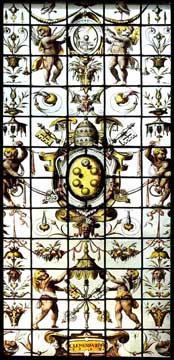Munich Pictorial Style Stained Glass Windows................... Stained Glass - Table of Contents................... Renaissance Architecture Styles
Renaissance and Reformation
Stained Glass Windows
15th-16th
centuries

|
Revival
of Renaissance style stained glass: |
During the Italian Renaissance, artworks done during the Middle Ages were considered barbaric. The artist's emphasis on during the Gothic era on religious symbolism was replaced by a new emphasis on three-dimensional perspective. The formerly divided sections of glass with lead beams became camouflaged as window sections appeared connected. Technological advancements permitted utilization of diamond blades and thinner glass; and, preference was for clear glass ("white") which permitted better light for viewing the Italian wall frescos.
Circa 1550, enamel colors were painted directly on to clear glass -- rather in a way that oil colors are applied to a canvas -- and then fired. This meant that the clear glass could be of regular shapes and increasingly it became normal to use rectangular panes, Leading became purely utilitarian and no longer served the artistic purpose of accentuating the painted lines.
|
The next change in style [after the Gothic era] reflected the humanist influence of the Renaissance. The figures became flesh and blood, suffered and rejoiced, and expressed human emotions. Figures were set in perspective and, as in painting, realism became the ultimate concern of the artist. Renaissance windows were designed by painters and sculptors unfamiliar with the role of lead in glass designs, and these artists objected to leaded compositions as being too crude for "modem styles." Thus, Renaissance artisans of the sixteenth century developed colored enamels, and these, coupled with silver stain and the old sepia enamels, allowed craftsmen to abandon completely the mosaic composition of colored pieces of glass bound together with lead. The traditional, idealized, didactic, and symbolic design and techniques gave way to windows filled with figures set in solid looking landscapes complete with buildings, skies, trees, birds, or set in interiors filled with their belongings and furniture.
|
|
Renaissance in England At the beginning of the 16th
century the spirit which had inspired English stained glass artists for
the past 300 years seems to have withered, and this decline was
accelerated by two importantevents: the employment of foreign artists,
mostly Germans or Flemings, to carry out large scale commissions ...
and later, the effect of the Reformation which officially brought
the making of religious stained glass windows to an end. Backgrounds of landscape or interiors treated in perspective replaced the older grounds of red or blue glass. Buildings, trees, perhaps with birds flying through clouded skies, would help to add realism to the landscape, while panelled walls, tiled floors, and even furniture would be shown in the interiors, in an attempt to create the illusion of depth. These windows are to be judged against the great mural paintings of the time rather than the traditional art of stained glass. Heraldry was still one of the most popular subjects for filling windows, especially after the Reformation, and it was in this type of decoration only that the high standard of medievalt echnique was maintained in the post-Reformation period. The Reformation, with its revolutionary change in religious opinion, prevented the making of religious windows, and until the end of the century glass painters concentrated upon the production of heraldic or secular windows. These often consisted of roundels set against plain glazed backgrounds. The subjects depicted were sometimes religious and used for private devotion; at other times they consisted of classically inspired scenes or merely scrolls with inscriptions in black-letter type. This marked the end of one of the great epochs of art and perhaps the greatest in English art. The Renaissance dealt the final death-blow to the art of stained glass from which it has not yetfully recovered.
|
Churches: There are secular scenes in church windows. In large church windows, the scenes extended over the whole, ignoring the mullions. Buildings portrayed in the windows are solid, in classical style, shown with correct perspective. Some action takes place far back from the picture plane with vistas in the distance. Faces have individuality and show emotion.
Secular buildings: Stained glass was used in secular buildings during the Renaissance period. Historic scenes or heraldry were placed in town halls and small panels (usually silver stain and paint on white [clear] glass) were incorporated into clear glass windows in homes. The labors of the seasons are a favorite theme during this period.Reformation: During the Reformation, stained glass windows with religious content are destroyed. These are replaced with clear glass or windows, either stained or enamel painted, with non-religious subject matter, like heraldic panels.
Stained glass reached a low ebb sometime between the late medieval age and the nineteenth century.
See also: The Stained Glass Association of America: History of Stained Glass: Renaissance Stained Glass
For information on the revival of Renaissance style stained glass, see Munich Pictorial Style Stained Glass Windows
Examples of Renaissance windows:
- Illustration above: Laurentian Library, Florence, Italy
- Santa Maria De Ricci Church, Florence, Italy
- Armorial Panel of Jacob von Fulach - Corning Glass Museum Switzerland
- Armorial Window from Sulgrave Manor, England - Corning Glass Museum
